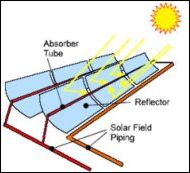Energy of the future - solar thermal power!
27 May 2008
Google, Goldman Sachs and oil firm Chevron believe that earth's future energy needs lie in the sun, and are willing to invest millions in that belief By Sourya Biswas
What does the largest search engine in the virtual world and the largest investment bank in the real world have in common, besides each being worth billion of dollars - in real money that is? Well, for one, Google and Goldman Sachs both believe that earth's future energy needs lie in the sun, and are willing to invest millions in that belief. And for good measure, they are joined by one of the biggest oil companies, Chevron, as well.
 All these big names have poured in big money in companies that specialise in solar thermal technology. This technology is a lot simpler technically than the more popular solar photovoltaic cells that convert sunlight directly to electricity. Here, sunlight is focused with mirrors to heat oil in glass pipes to about 370 degrees Celsius, which is used to turn water to steam. The steam spins an electric turbine to generate electricity by electromagnetic induction.
All these big names have poured in big money in companies that specialise in solar thermal technology. This technology is a lot simpler technically than the more popular solar photovoltaic cells that convert sunlight directly to electricity. Here, sunlight is focused with mirrors to heat oil in glass pipes to about 370 degrees Celsius, which is used to turn water to steam. The steam spins an electric turbine to generate electricity by electromagnetic induction.
Solar thermal collectors are characterised by the US Energy Information Agency as low, medium, or high temperature collectors. Low temperature collectors are flat plates generally used to heat swimming pools. Medium-temperature collectors are also usually flat plates but are used for creating hot water for residential and commercial use. High temperature collectors concentrate sunlight using mirrors or lenses and are generally used for electric power production.
However, we are concerned here only with the high temperature collectors, which some opine, can satisfy as much as 50 per cent of America's energy needs by 2020. Moreover, they feel that the cost of the technology, presently higher than coal, oil and gas, may soon fall below those of conventional energy sources. Considering the rapid rise that oil has seen in recent weeks, such beliefs are not entirely unjustified.
One of the biggest believers in this technology, and one of the earliest to put money in, is Indian-born venture capitalist Vinod Khosla. He has been one of the co-founders of Sun Microsystems and became a general partner of the venture capital firm Kleiner, Perkins, Caufield & Byers in 1986, after which he formed his own firm Khosla Ventures in 2004. Using his association with these firms he has invested heavily in renewable and new energy sources like ethanol and solar energy.
In September 2007, Khosla led a $40-million investment in solar power producer Ausra Inc. with Kleiner, Perkins, Caufield & Byers. Ausra's proprietary technology significantly reduces the cost of a solar thermal power plant and so is capable of significantly reducing global carbon emissions normally associated with electricity generation.
